I own a small library of books on the subject of bartending. Some of these books are geared toward the professional bartender, while others are written for the home mixologist. But regardless of the intended audience, almost every book I own heartily recommends that we use paring knives for cutting fruits and garnishes. The Art of the Bar, The Joy of Mixology, The Craft of the Cocktail, Larousse Cocktails, The Bartender’s Black Book, they all say the same thing: that a 4-inch paring knife is the right tool for the job.
But for my money (and the safety of my hands), there’s no better knife than a nine-inch, serrated, offset-handled sandwich sword.
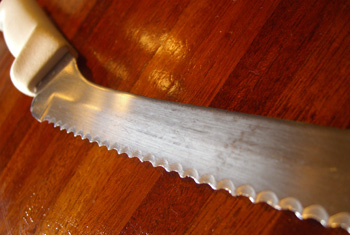
Forever used in sandwich shops and delis, the sandwich sword is the neophyte’s knife that can turn on a dime in the right hands with just a little practice.
See, I don’t trust small knives. They’re vertically-challenged, which means that the height of their blades is short, so cutting requires razor-sharp precision. And that’s something I don’t always have during the middle of a busy Friday night, if ever. Let’s face it, wet hands and a sharp knife are kind of a scary combo. And the offset silicone handle is easy on the the hands and knuckles.
Another reason I prefer my knife to theirs it that a four-inch blade doesn’t work well with larger items like pineapples and grapefruits, so those fruits end up coming out looking butchered. And for the few that have ever worked with me, you know how particular I am about my garnishes. Sloppy angles, dented fruit and torn peels are a thing of the past with the old sandwich sword. My garnish trays are always full of fresh fruit with crisp, clean edges.
Citrus peels are often thick and sometimes full of grit, which will dull a blade quickly. But my sandwich sword is serrated, so it keeps a usable edge for longer. I can still straighten the edge with a steel I keep behind the bar, but once it’s passed a certain point I don’t mind throwing it out and getting a fresh one. They’re only ten bucks.
Am I the only one out there who uses a monster like this? Let me know in the comments.
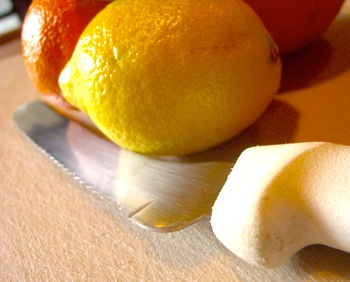


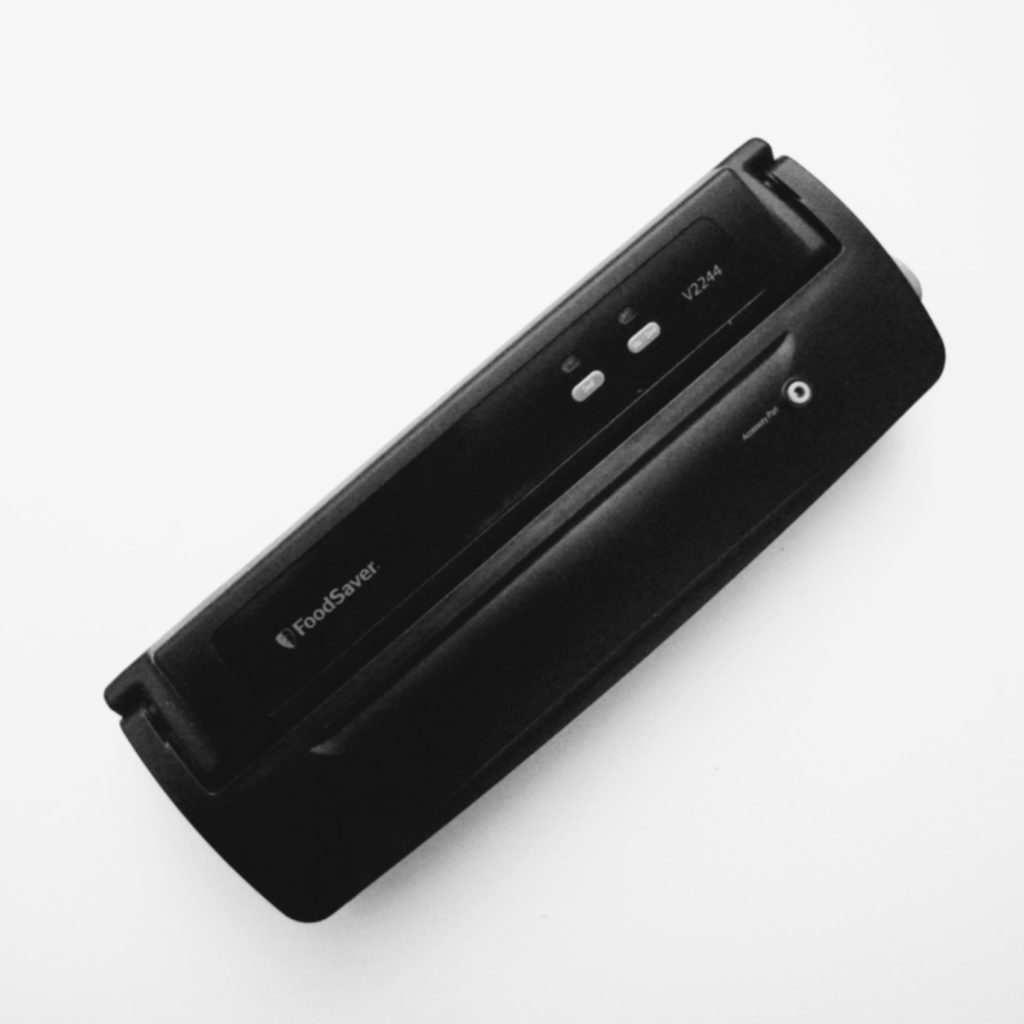
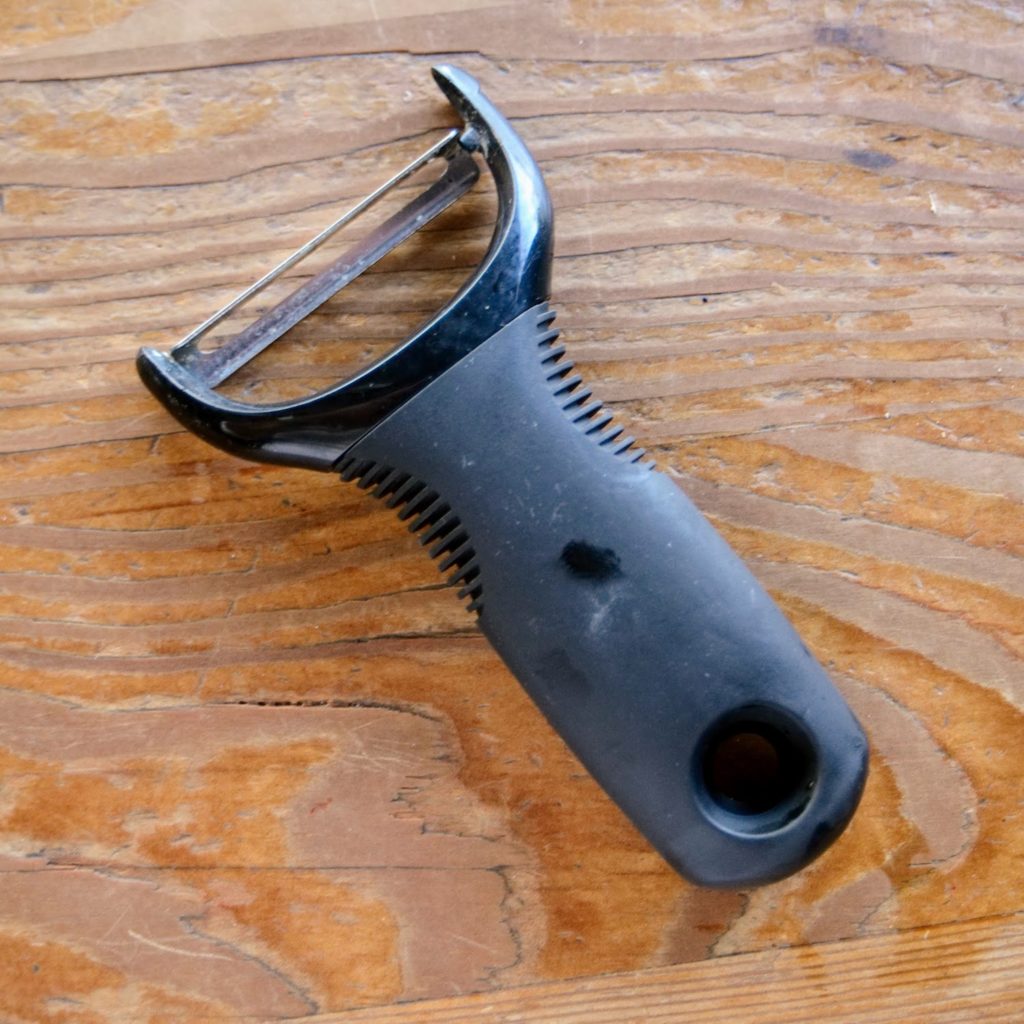
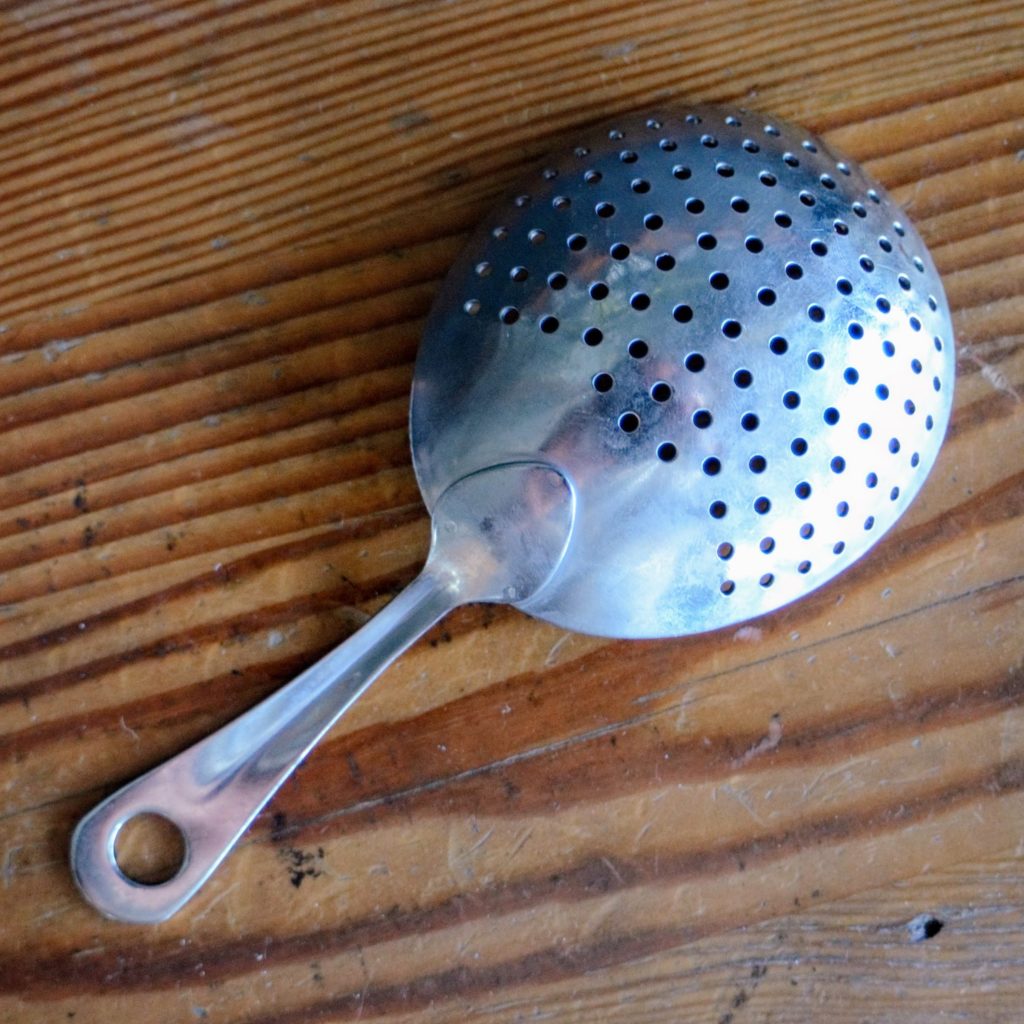
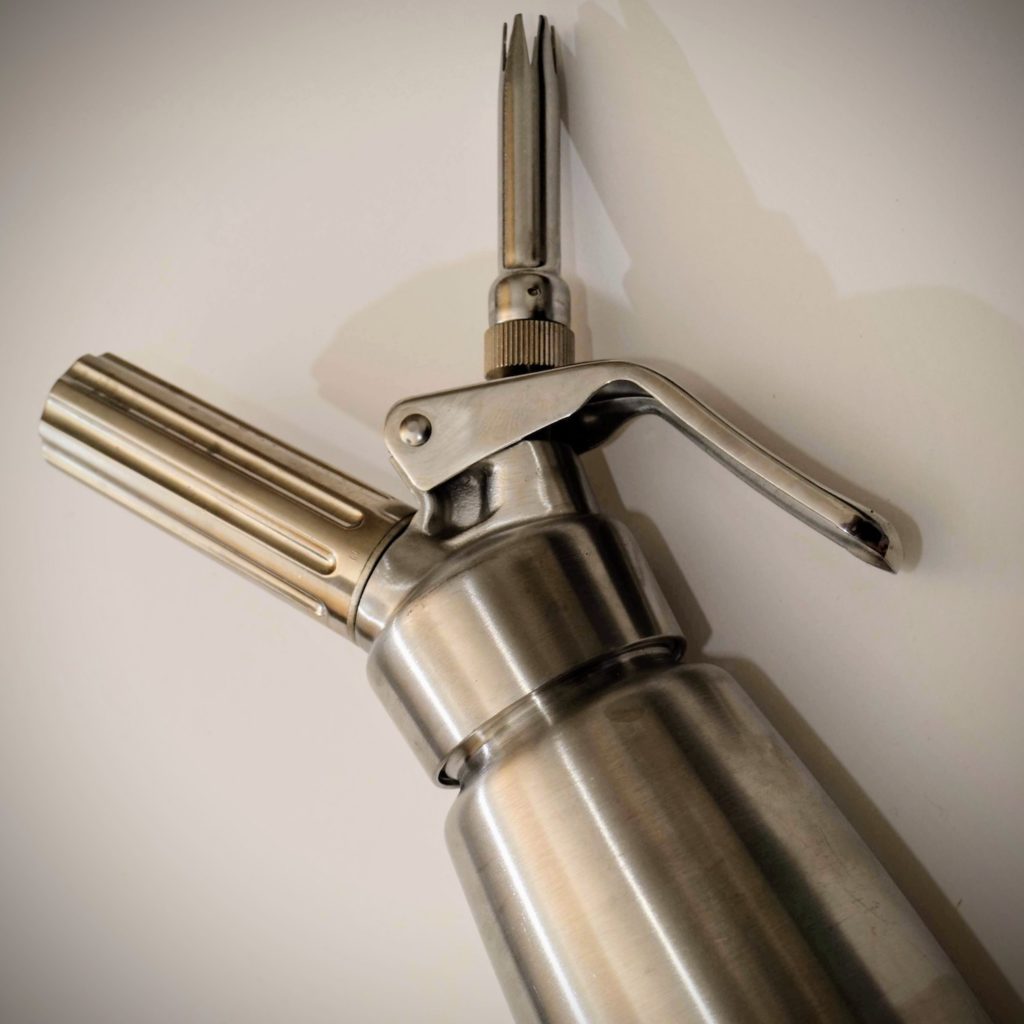
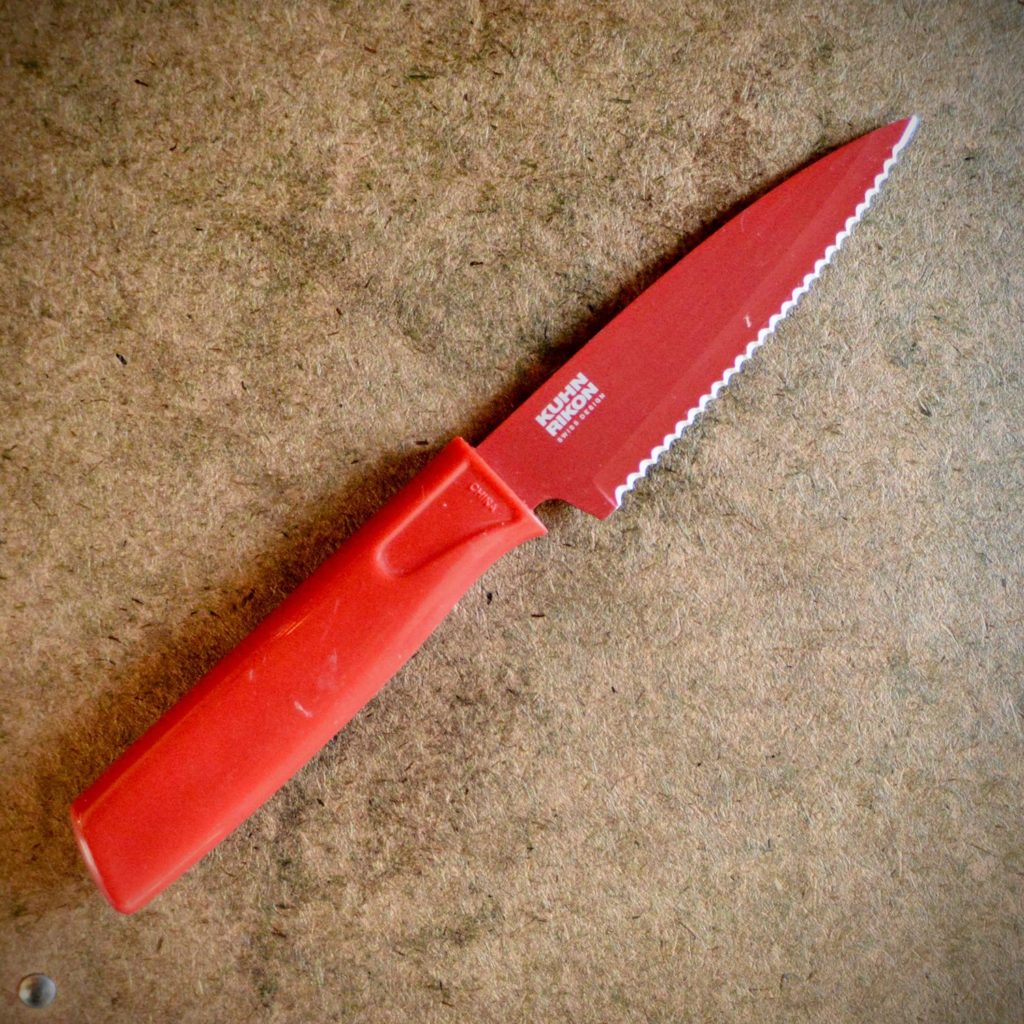
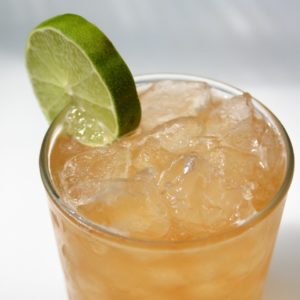



Hi Jeffrey,
Thanks for sharing this. Interesting knife you use for your fruits. I stick to the original.
In terms of tools of the trade, I run a small website on all types of knives http://whatsthatknife.com
thanks again,
Jason
I’m glad to read someone else is using the big bread knife. I’ve used this same type knife for ten + years. If the guys in the kitchen steal it I steal it back. Then hide it better.
I’ll have to throw in with the serrated crowd on juicing and wedges, but note that my clumsiness (or is that laziness?) makes me pull out the santoku for cutting the uber-thin slices that can look nice floating.
I’ll throw my vote for the 6.5″ santoku, the only time I’ve used a different knife in the past two years is when it’s dirty and I don’t feel like washing it. Holds an extremely sharp edge and I have never had trouble carving with it, plus the shape makes it naturally easy to avoid slipping and cutting yourself.
In professional kitchens, everyone has their own knives and other small tools and woe betide anyone who touches, let alone uses, another’s knives. It seems to me this is an excellent model for bars, especially as you begin to find more professional “bar chefs.”
Cheers. – S
That’s some great information, chef Brendan, thanks for writing in!
A cool experiment to show the way serrated knives affect foods is to dice 2 peppers. One with an off set serrated slicer and one with a sharp standard santuko or chefs knife. Sweat the two in separate pans and watch the juices run out of the serrated pepper. As the serrated knife passes through the fruit or vegetable it makes lots of small tears that cause this weeping during cooking, making it a pour choice for anything that will be cooked, but an excellent choice for foods served raw, like garnishes. As the serrated knife passes trough your lime you are exposing more of the flesh which will pass on the intensity of aroma that is the reason you put the lime on the rim in the first place. And for juicing, your serrated knife has started the process for you!
I just use one of our restaurants old school steak knives that has a serated blade the full length of the blade. Its about six inches and works perfectly
Agree on the serrated bread knife.
During my past years in the kitchens i`ve experienced a few of these “tiny blade slipping and slicing into my hand in the middle of a rush” things and i`m more careful now.
The bread knife does a good job and the serrated edge helps start the cut nicely.
Glad to see I’m not the only one who slings one of these things about (though I occasionally use a 6″ santoku as well)…
I got into food & drink working in a high-end deli – the bread knife is indeed a suprisingly-marvelous tool.
Cheers!
…sorry and now the right link!
http://web.mac.com/opinionatedalchemist/the_opinionated_alchemist/the_opinionated_bar-log/Entries/2007/10/8_bar-tool-mania_I_-_bar_knives!.html
(might need to be copied into address line)
A very long blade just doesn’t work out for me…
I am more with Darcy – take out your ceramic knife and just watch it carefully.
I tell my bartender, that there is a serious curse on the knife – if the touch it, the bad bartender spirits are obsessing them…
I also wrote last year about my perfect knife…
check this out…
http://web.mac.com/opinionatedalchemist/the_opinionated_alchemist/the_opinionated_bar-log/Entries/2007/10/8_bar-tool-mania_I_-_bar_knives!.html
Try going through 2 cases of limes between 2 tenders in 2 hours (after you’ve gone through prepped fruit).I call it more-jitos and more-jito madness!
I worked in a bar for almost three years that used a hamilton beach juicer and nothing from a can or bottle for juice. J’s knife recommendation is spot on..I can not believe the accuracy and speed you also have the best length of handle and blade…I still have all my fingers.
I love my Rosle Boston Shaker and bar accessories 🙂
Jeff,
With all the discussion on knives, I thought it might make a great topic to discuss our favourite barware.
What’s your shaker of choice? Who makes the best hawthorne strainer, jigger, barspoon, etc…?
If you were to put together the ultimate “everything-you-need” bar kit, what would it consist of?
Blair
My all-time favorite knife is a 7-inch Chinese vegetable knife.
It’s a no-name brand I got at Target for 15 bucks and it works like a charm. For a cheapo knife it’s amazingly well-balanced and incredibly comfortable in the hand. I use it for 99% of my kitchen cutting tasks.
I can’t imagine going back to a paring knife for my garnishes. It whacks up limes, lemons, pineapples and other stuff without me having to muscle it. I do have to sharpen it fairly frequently, but I imagine a “real” brand-name knife will hold an edge longer.
It looks similar to this:
http://www.cooking.com/products/shprodde.asp?SKU=198393
That 6.5″ Wusthoff that was linked is pretty nice looking. I may have to invest in that. I have a smaller Wusthoff for garnishing that I love.
Jeff,
As a left hander, a serrated knife just doesn’t work for me. I do watch others in the bar using the bread knife with ease but it is no good for me, as I always end up with crooked or bad cuts!
I use a 12″ Victorinox Chefs knife. I give it a good run on the steel before service every Friday night and it lasts all week. Had it for about 12 months now, only cost me $30(AUD). I will never go back.
I also bought the 6″ pairing knife for the more delicate jobs.
Cheers!
I use a 6″ ceramic knife for cutting limes, etc. I like the additional size over the paring knife I used to keep in the bar, but it has a much bigger advantage.
It is SHARP. and it stays that way. I’m one of those who are sharp nazis. If your blade is really sharp, it does more for control and safety than size.
Yeah, I do wonder how long a non-scalloped knife will hold an edge when confronted by a 40-pound box of limes.
These are the only knives we ever had when I used to tend bar. Probably because they’re cheap at restaurant supply stores? They are easy to use when you’re cutting forty pounds of lemons.
The versatile santoku knife does just fine for me. I use a 6″ blade.
Ryan and Jacob, thanks for the links, I will have to do some investigating.
Jimmy, suck it.
Darcy, I’m intrigued but I always end up sharing with the rest of the bar staff, so I worry about ceramic blades as a usable option for my bar. But I might just take your advice for the home bar…
I’m in full agreement with Jeffrey here. I’ve used these giant knives for cutting fruit in the last two places I’ve worked and they’re a godsend. Last thing I need is some tiny blade slipping and slicing into my hand in the middle of a rush.
For me, I prefer a ceramic Santoku knife with a 6 inch blade. These things are ultra sharp and really do a great job on lemons/limes and even a pineapple because they are so sharp.
The one problem is that ceramic blades can chip if bashed against a cutting board.
Lesson learned: Don’t lend the knife to other bartenders.
I’ve largely abandoned paring knives in favor of the knife I use for 95% of all my cooking needs, a Wusthof Gran Prix 6.5″ Santoku (http://tinyurl.com/4tb52d), since it can do everything a paring knife can do and more, with equal agility. Nice not-too-big-not-too-small size, too, at least for my gargantuan circus-freak hands. More precision than a serrated blade can provide, too. I think you’d dig it.
overcompensating?
Being a home bartender rather than a professional one, I have the advantage of using my assortment of cooking knives when making garnishes or cutting up fruit.
That said, I’m a stickler about having good, sharp knives because I like my fingers where they are. In general, paring knives are great for scoring or seeding, but I generally turn to my chef or bread knives when I need to do anything else.
Jeff,
You & I must think alike! I’ve been using a nine-inch serrated bread knife for all of my fruit cutting and garnish work for years! The serrated edge not only helps start the cut, but the extra length helps do it quicker.
Blair
I recently bought one of the Kuhn Rikon paring knives for home use and have been very happy with it so far. Very sharp, and comes with a convenient plastic sheath for easy storage/portability. If you don’t mind a small knife, it’s a good option. Also just ten bucks.
http://www.amazon.com/Kuhn-Rikon-2814-Non-stick-Paring/dp/B000GZA38I/ref=pd_bxgy_k_text_b
Thanks for the sandwich knife suggestion.